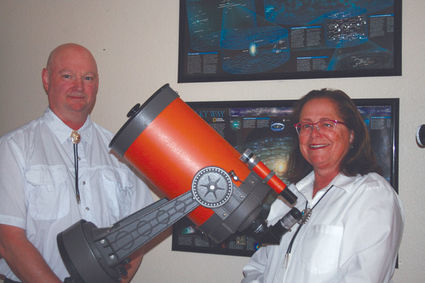NASA/JPL Appoints Tehachapi Solar System Ambassadors
Tehachapi Sky Watch

"NASA/JPL's New Solar System Ambassadors" – Dale Hawkins and Lauren Hollen. Photo provided by Lauren Hollen.
Lauren Hollen, retired Tehachapi High School Science Teacher, and I have been selected by the Jet Propulsion Laboratory in Pasadena to represent it and the rest of NASA as Solar System Ambassadors. The program is part of NASA's public education and outreach efforts. It taps the energy and talents of motivated and qualified volunteers from across the nation to bring space exploration to local communities and encourage Americans to pursue education in science, technology, engineering, and math. Perhaps most important, we wish to ensure that everyone knows that we are all in this exciting journey to the stars together! Lauren and I plan to work closely with our local schools, youth groups, astronomy clubs, aviation groups, civic leaders, and anyone else who is interested in ensuring that we all have access and input into America's space programs.
While Lauren and I will work closely together, we will develop distinct areas of interest. Lauren will keep us engaged in the slow, but steadily progressing march toward the planet Mars; while I will continue to pursue a long-standing concern regarding planetary defense from 'near earth objects' (like the rather large rock that just missed Chelyabinsk, Russia, last year). This includes NASA's plans to capture a small asteroid and send a manned expedition to explore it.
Candidates from around the country are appointed as ambassadors each year based on their interest, professional qualifications, and community involvement. Lauren Hollen is known personally to most of you as one of the best science teachers Tehachapi High School has ever had. What you may not know is that she was a CalTech neurobiology research technician before moving to Tehachapi, and holds a Master of Science Degree in Biological Science from CalPoly. She was a shoe-in. I have an aviation and engineering background, including a design currently flying aboard the International Space Station, but I'm sure I was accepted because of Lauren's pull.
Information about the NASA/JPL Solar System Ambassador Program can be found at http://www2.jpl.nasa.gov/ambassador/. Lauren can be contacted at llhollen@hotmail.com or 661-822-4079. I can be contacted at hawk@ieee.org or 661-809-7207, or through The Loop.
Disclaimer: It is important (I am told) that I state for the record that any opinions I may express in my column from time to time do not necessarily reflect the official position of NASA or JPL – or the publishers of The Loop, for that matter.
Almanac
Winter often brings weather that makes for poor sky watching (especially for those of us who like it a little warmer). However, when it's clear and still, the views are superb, especially in our darker alpine skies. February will again be a fine month for planetary viewing. All of the naked-eye planets are on the same side of the sun and will make an appearance this month. Jupiter will be bright in the east at dusk with Mars rising around bedtime, followed by Saturn a bit after midnight.
Few astronomers brave the cold just to look at planets! The Milky Way – the name of our home galaxy – arches high above us, gracefully pirouetting around the sky as Orion (with his iconic three-starred belt) drifts from east to south and then to west as the night progresses. The sword hanging from Orion's belt contains the northern sky's most dazzling nebula (Greek for 'cloud'). The Great Orion Nebula, most commonly known as M42, is a maelstrom of gas and dust where stars and planets are being born. It can easily be seen with binoculars (and even by those with keen naked eyes). A telescope can really peer into its heart.
That is just the beginning of the wonders to be found along the disk of our galaxy. Get out the lawn chairs, fire up the hot chocolate (or toddies), put on plenty of layers, lay back with your binoculars, and ponder the depths of the cosmos. Few people in the world have a sky this good to work with (especially if you live outside of town)!
The moon will be an increasing evening problem as February progresses. However, star-struck lovers will be treated to a full moon rising on the evening of Valentine's Day, the 14. The moon will be less of an evening problem as the month progresses.
Keeping an eye above the horizon... Sunrise/Sunset (Feb. 1) 6:53 a.m./5:22 p.m.




